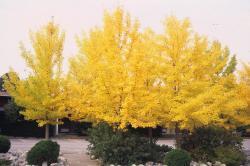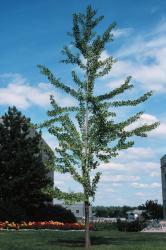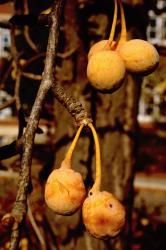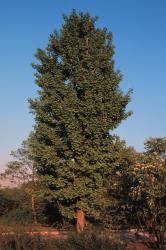| Ginko biloba Ginko, Maidenhair Tree
|
| Description | It is well worth planting a ginkgo for the next generation. While slow to grow when young, with advancing age the ginkgo becomes a striking tree with interesting winter form and even more interesting foliage. |
| Usage | Buffer strip, street tree, boulevard, specimen. |
| Origin | China, fossil record worldwide |
| Hardiness zone | 4 |
| Size | 15-25m |
| Form/texture | Variable at any age, irregular when young, aging to open pyramid. |
| Growth rate | Slow, but long-lived. |
| Leaf | Alternate, simple, lobed, bright green turning bright yellow before dropping in fall. |
| Flower | Fragrant, inconspicuous, dioecious. Flowers will not appear until trees are older than 20 years (Dirr) or 40 years (Jacobson). |
| Fruit | Small, fleshy and smelly, but only on female trees. |
| Exposure/culture | Full sun to part shade. Tolerates all soil textures and wide range of soil pH. Tolerant of very dry soils. Moderately tolerant of deicing salt (Beckerman et al, Morton). Few pests. Easily transplanted, recovery is quicker with adequate irrigation and fertility. |
| Comments | This species has merits that are well known. Virtually pest-free and incredibly tolerant of urban conditions, there are Ginkgo specimens that are centuries old living in cities around the world. "The Maidenhair tree is sacred according to the Buddhist religion and has been cultivated for many centuries in China and Japan, especially in the grounds of temples" (Cafferty). One could even argue that Ginkgo is a species native to Ontario, as fossil records show that this tree was indeed indigenous here millions of years ago. For all the virtues of Ginkgo, some will avoid it due to the messy and stinky fruits. Washing off the smelly outer flesh reveals a delicious nut prized by many in Asia. Fruitless, male cultivars are available in numerous shapes and sizes. Ginkgo has a fairly slow growth rate, but this shouldn't be reason to avoid planting them. Patience when growing this species is more than rewarded in the long-term. Unfortunately, too many landscape plans call for fast-growing trees that are structurally weak and short lived. Ginkgo is a tree that should be considered a sound investment that can be planted with confidence for the long term. |




Reference:
Beckerman, J. and B.R. Lerner. 2009. Salt Damage in Landscape Plants. Purdue Extension Publication ID-412-W. Purdue University. West LaFayette, IN.
Cafferty, S. 2005. Firefly Encyclopedia of Trees. Firefly Books. Richmond Hill, ON.
Dirr, M. 1998. Manual of Woody Landscape Plants. Stipes Publishing, Champaign, Illinois 1187 pp.
Jacobson, A.L. 1996. North American Landscape Trees. Ten Speed Press, Berkely California. 722 pp.
Morton Arboretum Salt Tolerant Trees. Michigan State University Extension Service Publication, HM-95